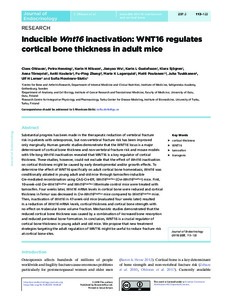Inducible Wnt16 inactivation: WNT16 regulates cortical bone thickness in adult mice
Marie K. Lagerquist; Juha Tuukkanen; Petra Henning; Antti Koskela; Karin H. Nilsson; Sofia Movérare-Skrtic; Klara Sjögren; Fu-Ping Zhang; Karin L. Gustafsson; Jianyao Wu; Claes Ohlsson; Matti Poutanen; Anna Törnqvist; Ulf H. Lerner
Inducible Wnt16 inactivation: WNT16 regulates cortical bone thickness in adult mice
Marie K. Lagerquist
Juha Tuukkanen
Petra Henning
Antti Koskela
Karin H. Nilsson
Sofia Movérare-Skrtic
Klara Sjögren
Fu-Ping Zhang
Karin L. Gustafsson
Jianyao Wu
Claes Ohlsson
Matti Poutanen
Anna Törnqvist
Ulf H. Lerner
BIOSCIENTIFICA LTD
Julkaisun pysyvä osoite on:
https://urn.fi/URN:NBN:fi-fe2021042719143
https://urn.fi/URN:NBN:fi-fe2021042719143
Tiivistelmä
Substantial progress has been made in the therapeutic reduction of vertebral fracture risk in patients with osteoporosis, but non-vertebral fracture risk has been improved only marginally. Human genetic studies demonstrate that the WNT16 locus is a major determinant of cortical bone thickness and non-vertebral fracture risk and mouse models with life-long Wnt16 inactivation revealed that WNT16 is a key regulator of cortical thickness. These studies, however, could not exclude that the effect of Wnt16 inactivation on cortical thickness might be caused by early developmental andor growth effects. To determine the effect of WNT16 specifically on adult cortical bone homeostasis, Wnt16 was conditionally ablated in young adult and old mice through tamoxifen-inducible Cre-mediated recombination using CAG-Cre-ER; Wnt16(flox/flox) (Cre-Wnt16(flox/flox)) mice. First, 10-week-old Cre-Wnt16(flox/flox) and Wnt16(flox/flox) littermate control mice were treated with tamoxifen. Four weeks later, Wnt16 mRNA levels in cortical bone were reduced and cortical thickness in femur was decreased in Cre-Wnt16(flox/flox) mice compared to Wnt16(flox/flox) mice. Then, inactivation of Wnt16 in 47-week-old mice (evaluated four weeks later) resulted in a reduction of Wnt16 mRNA levels, cortical thickness and cortical bone strength with no effect on trabecular bone volume fraction. Mechanistic studies demonstrated that the reduced cortical bone thickness was caused by a combination of increased bone resorption and reduced periosteal bone formation. In conclusion, WNT16 is a crucial regulator of cortical bone thickness in young adult and old mice. We propose that new treatment strategies targeting the adult regulation of WNT16 might be useful to reduce fracture risk at cortical bone sites.
Kokoelmat
- Rinnakkaistallenteet [19207]
